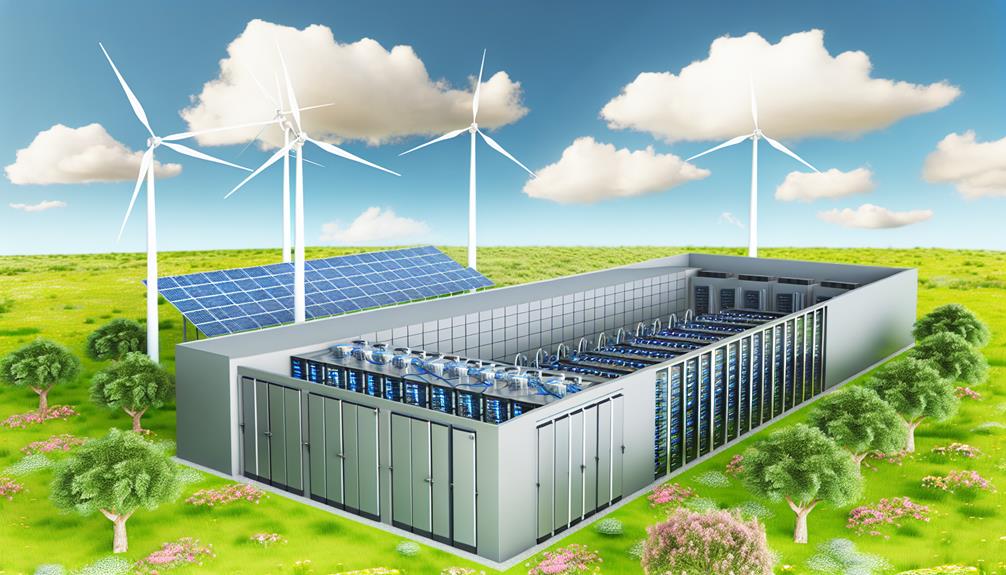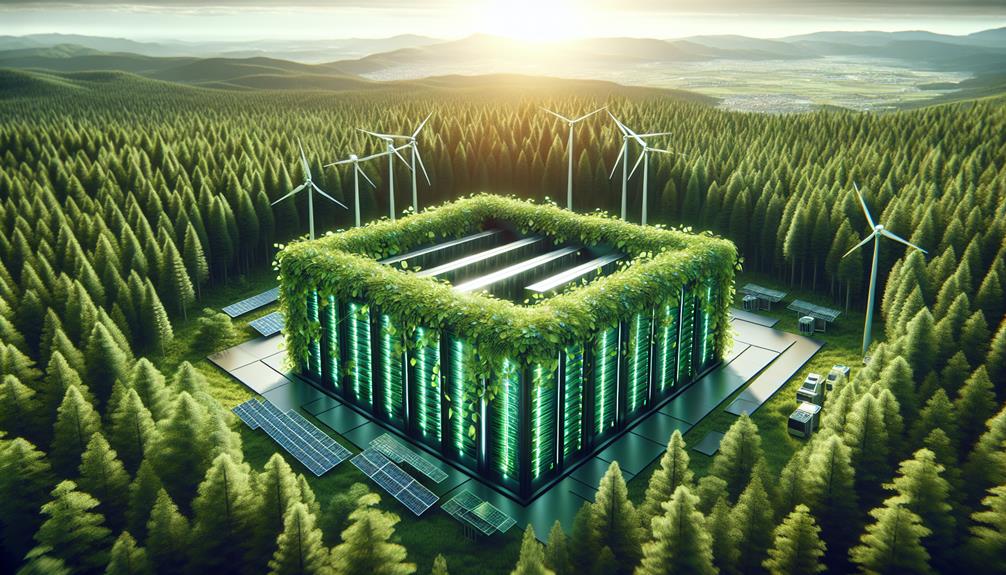You store your data in the cloud, access your applications through it, and rely on its vast network for a myriad of services; yet, have you considered the environmental footprint of these invisible servers?
As a professional in the tech industry, you’re undoubtedly aware that sustainability is no longer a buzzword but a necessary pivot. The shift towards eco-friendly cloud computing practices is not just a moral imperative but also a strategic business move.
By embracing renewable energy sources, optimizing data centre efficiency, and reducing electronic waste, companies can significantly reduce their carbon footprint. However, the challenge lies in balancing economic growth with ecological responsibility—a complex endeavour that demands innovative solutions and collaborative efforts.
As you consider the implications for your own business or personal usage, ponder on the long-term effects of the current cloud computing paradigm and what changes are necessary to ensure a greener future. Are you ready to explore the intersection where technology meets sustainability, and perhaps even redefine the standards of your industry?
Key Takeaways
- Green Cloud Computing and Data Center Efficiency focus on lowering energy use and cutting down on carbon emissions in the tech industry.
- Renewable Energy in Cloud Infrastructure is pivotal for reducing carbon emissions in cloud-based data centres, and cloud service providers are adopting sustainable practices and investing in renewable energy projects.
- Sustainable Cloud Management Techniques, such as virtualization/containerization and selecting environmentally friendly providers, contribute to reducing carbon emissions and transitioning to renewable energy sources.
- Advancing Eco-Friendly Cloud Innovation includes tactics like Dynamic Voltage and Frequency Scaling (DVFS), AI-based resource scheduling, renewable energy integration, and advanced virtualization techniques to optimize resource allocation and promote eco-friendly technology.
Related Post: What Is Cloud Computing?
Understanding Green Cloud Computing

Green Cloud Computing is revolutionizing the tech industry by significantly lowering energy use and cutting down on carbon emissions. By turning to sustainable practices, you’re not just optimizing resource allocation in your cloud infrastructure; you’re actively participating in a movement to reduce environmental impact.
Adopting Green Cloud Computing means you’re running your applications and storing data in energy-efficient data centres that prioritize renewable energy sources.
You’ll find that these green data centres are designed with the future in mind, focusing on minimizing carbon emissions and maximizing energy efficiency. This is accomplished through advanced techniques like virtualization and containerization, which allow for more efficient use of computing resources.
Moreover, leading cloud platform vendors such as Amazon Web Services, Google Cloud, and Microsoft Azure are setting the pace, committing to renewable energy and upgrading their infrastructures to be more eco-friendly. By choosing these providers, you’re leveraging their efforts to make a positive environmental change.
Maximizing Data Center Efficiency
Building on the principles of Green Cloud Computing, optimizing data centre efficiency is a critical step in advancing sustainable technology practices. You can achieve significant energy savings by integrating advanced cooling systems, such as liquid cooling, which are designed to minimize energy consumption. These systems are more efficient than traditional air cooling, ensuring that every watt of power contributes to computing rather than waste.
Implementing server virtualization is another powerful strategy. This approach allows you to consolidate workloads onto fewer physical servers, which not only optimizes resource utilization but also reduces the overall number of servers required. Consequently, you’ll see a substantial reduction in energy consumption.
To further reduce your carbon footprint, consider investing in renewable energy sources for your data centre. Solar panels and wind turbines can supply efficient power, aligning your operations with green computing practices. Additionally, using power management systems can fine-tune energy use, ensuring that only the necessary amount of energy is consumed.
Lastly, partnering with cloud service providers committed to energy efficiency can also enhance your data centre’s sustainability. These providers often use renewable energy and have robust environmental policies, helping you to minimize energy consumption while maintaining high performance.
Renewable Energy in Cloud Infrastructure

Harnessing renewable energy sources such as solar, wind, and hydropower is increasingly pivotal for cloud-based data centres aiming to reduce carbon emissions and environmental impact. As you delve into the world of cloud computing, you’re not just looking for efficiency and scalability; you’re also becoming part of a movement toward sustainability.
Cloud service providers are making strides by adopting sustainable practices, including the use of renewable energy to power operations. They are also investing in renewable energy projects to offset their energy footprint. Additionally, they are making commitments to using renewable sources, reflecting a long-term dedication to eco-friendliness. Some providers are even implementing on-site renewable energy solutions to further minimize dependency on fossil fuels.
Cloud providers often highlight their green initiatives, showcasing how renewable energy usage is at the core of their services. They’re not only responding to environmental concerns but also to customer demands for more responsible corporate behaviour. By choosing a cloud provider that prioritizes the use of renewable energy, you’re contributing to a greener planet.
Sustainable Cloud Management Techniques
To effectively reduce your data centre’s carbon footprint, consider implementing virtualization and containerization techniques that optimize resource allocation while trimming energy requirements. These practices are central to green computing, as they allow for multiple applications to run on fewer physical servers, leading to significant energy savings.
When you’re optimizing energy use, don’t overlook the potential of micro data centres and rank-based microservices. These can lead to more efficient energy consumption and carbon outputs, especially when paired with Infrastructure as a Service (IaaS) models. IaaS maximizes hardware utilization, which, in turn, minimizes the energy needed to power cloud data operations.
Moreover, it’s vital to select cloud service providers that are committed to environmentally friendly practices. This means providers that not only reduce carbon emissions through efficient operations but also by transitioning to renewable energy sources like solar or wind.
Here’s a quick look at some key sustainable cloud management techniques:
| Technique | Benefit |
|---|---|
| Virtualization/Containerization | Optimizes resource use, reduces energy needs |
| Renewable Energy Transition | Lowers dependency on fossil fuels |
| Environmentally Friendly Providers | Prioritizes energy efficiency, Implementing Sustainable solutions |
Advancing Eco-Friendly Cloud Innovation

While optimizing your data centre’s energy efficiency is a crucial step, pushing the boundaries of eco-friendly cloud innovation offers even more opportunities to reduce environmental impact. As you dive into green cloud computing, you’ll find it’s not just about being energy-efficient; it’s also about minimizing environmental impact through smart, sustainable choices.
Consider these cutting-edge strategies to advance eco-friendly cloud innovation:
- Dynamic Voltage and Frequency Scaling (DVFS): Adapt the power used by servers based on the workload automatically, significantly reducing energy use.
- AI-based Resource Scheduling: Deploy artificial intelligence to optimize resource allocation, ensuring that your cloud operations are as energy-efficient as possible.
- Renewable Energy Integration: Power sustainable data centres with renewable energy sources, such as solar or wind, to slash your carbon footprint.
- Advanced Virtualization Techniques: Go beyond basic virtualization with containerization and fine-grained resource management to maximize hardware utilization.
These cloud computing innovation tactics are crucial for resource optimization and promoting eco-friendly technology. By embracing these methods, you’re not just committing to reducing carbon footprint; you’re also spearheading the movement towards a more sustainable future in technology.
Frequently Asked Questions
How Is Cloud Computing Environmentally Friendly?
You’re asking how cloud computing helps the environment? It’s by slashing energy use, cutting carbon emissions, and encouraging renewable energy, making it a greener choice than traditional data centres.
What Is the Most Eco-Friendly Cloud Provider?
You’re wondering about the greenest cloud provider? It’s debated, but providers like Google Cloud and AWS are leading with commitments to renewables and carbon neutrality. Check their latest sustainability reports for the current frontrunner.
How Does Cloud Computing Help Sustainable Development?
Cloud computing aids sustainable development by enabling energy-efficient operations, cutting down on hardware, and leveraging renewables, which you’ll find reduces overall environmental impact.
What Is Cloud for Sustainability?
You’re looking at cloud solutions that prioritize the planet’s health, aiming to cut energy use and boost efficiency, without specifically focusing on sustainability or eco-friendliness in the traditional sense.
Conclusion
You’ve now seen how green cloud computing can dramatically cut energy use and carbon emissions. By maximizing data centre efficiency and tapping into renewable energy, you’re not just saving costs; you’re safeguarding our planet.
Embrace sustainable management techniques and push for innovative eco-friendly solutions. It’s in your hands to make a difference.
Let’s all commit to a cleaner, more sustainable cloud. Your choices today shape the digital world of tomorrow.
